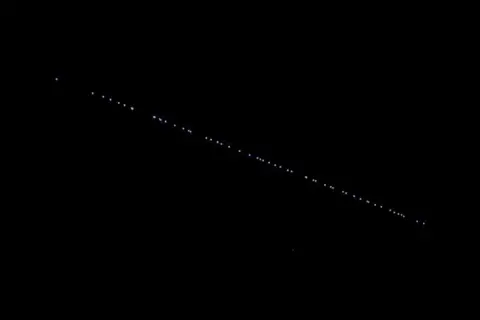 Getty Images
Getty ImagesRadio waves from Elon Musk’s growing network of satellites are blocking scientists’ ability to peer into the universe, according to researchers in the Netherlands.
The new generation of Starlink satellites, which provide fast internet around the world, are interfering more with radio telescopes than earlier versions, they say.
The thousands of orbiting satellites are “blinding” radio telescopes and may be hindering astronomical research, according to Netherlands Institute for Radio Astronomy (ASTRON).
SpaceX, which owns Starlink, has not replied to a request from BBC News for comment.
The satellites provide broadband internet around the world, often to remote places, including challenging environments like Ukraine and Yemen.
They are also used to connect remote areas of the UK to fast internet. In 2022 tests showed that Starlink could deliver internet speeds four times faster than the average, according to the Department for Digital, Culture, Media and Sport.
But astronomers say this comes at a cost.
“Every time more of these are launched with these kinds of emission levels, we see less and less of the sky,” Professor Jessica Dempsey, director of ASTRON, told BBC News.
“We’re trying to look at things like the jets, which are emitted from black holes in the centre of galaxies. We also look at some of the earliest galaxies, millions and millions of light years away, as well as exoplanets,” she said, highlighting the areas the satellite radiation is affecting.
Interference from the second generation, or V2, satellites was found by ASTRON to be 32 times stronger than the first generation.
 Getty Images
Getty ImagesThe amount of radiation emitted exceeds regulations set by the industry body the International Telecommunications Union, Prof Dempsey added.
One estimate suggests there are 6,402 Starlink satellites currently in orbit at around 342 miles (550km) above Earth, making it the largest provider by far.
The satellites are relatively large – with 3m flat panels and an 8m solar array for power.
SpaceX’s main competitor, OneWeb, has fewer than 1,000. But it is a growing business area. Amazon is developing its own network and hopes to launch at least 3,000 in the next few years.
By 2030 the number of satellites in orbit is expected to surpass 100,000.
The study was done using the LOFAR radio telescope in the Netherlands on a single day in July earlier this year.
Many objects in space, including distant galaxies and planets, emit light on the electromagnetic spectrum.
This radiation travels like waves and radio telescopes can pick up on those waves, allowing us to get a picture of things we can’t see with our eyes.
But those waves are being disturbed by satellites.
The scientists found unintended electromagnetic radiation from almost all the V2 Starlink satellites observed.
It was about 10 million times brighter than from the weakest sources of light identified, they say.
 Reuters
ReutersLead author Cees Bassa said it was like comparing the “faintest stars visible to the naked eye and the brightness of the full Moon.”
“Since SpaceX is launching about 40 second-generation Starlink satellites every week, this problem is becoming increasingly worse,” he added.
Robert Massey, Deputy Executive Director of the Royal Astronomical Society in the UK, said: “it’s very clear that if you have something this bright that is compromising a major radio observatory this much, then we need to do something and we need to do it quickly.”
Asked about the value of the astronomy research, he said: “it’s wrong to say that there is some science that you can simply dismiss. The applications may be decades or even longer in the future but they can be very fundamental and very important.”
Scientists are also worried about light pollution from the satellites, and fear it is also interfering with optical telescopes.
Astronomers say they talked to SpaceX about radiation from the first generation of satellites and the company listened to their concerns.
But ASTRON now say the V2 have been found to be even more powerful.
“Turning LOFAR back up and seeing these booming signals from these new generation of V2 Mini SpaceX satellites was a bit shocking,” says Prof Dempsey.
“This is actually threatening the entirety of ground based astronomy in every wavelength and in different ways. If it continues, without the sort of mitigation to make these satellites quiet, then it does become an existential threat for the kinds of astronomy we do,” Prof Dempsey added.
The researchers stress that more regulation of space and how satellites operate is needed to avoid scientific work being compromised.
They said that as the largest provider of satellites, SpaceX could set a standard for limiting pollution.
Prof Dempsey said that simple actions like shielding the battery on the satellite could make a big difference and reduce the radiation emitted.
Some interference comes from faulty electronics, so this could prevent that happening.
But without action, “very soon the only constellations we will see will be human-made,” she added.
The findings are published in the scientific journal Astronomy and Astrophysics.


